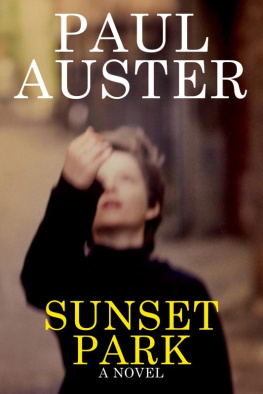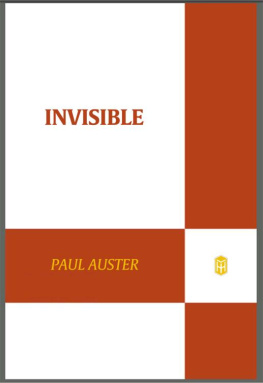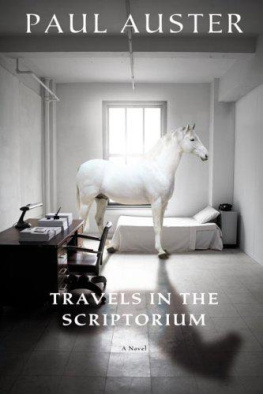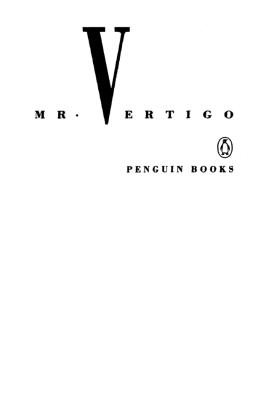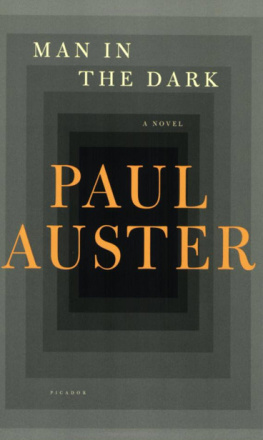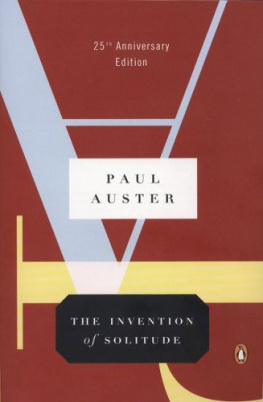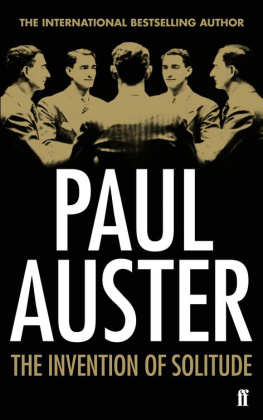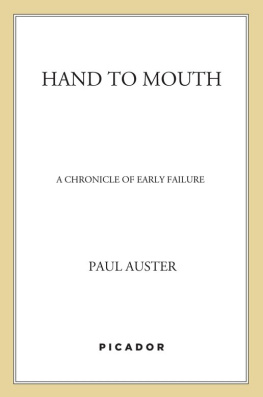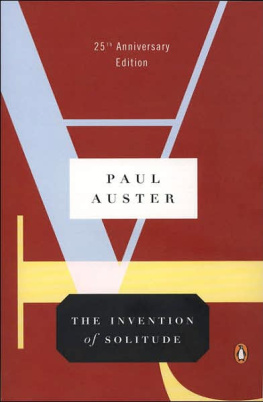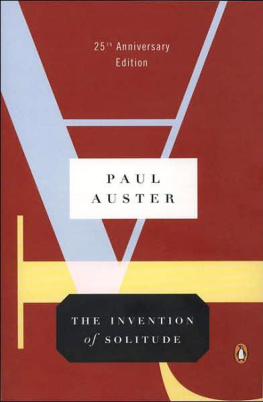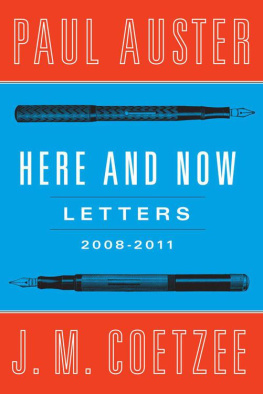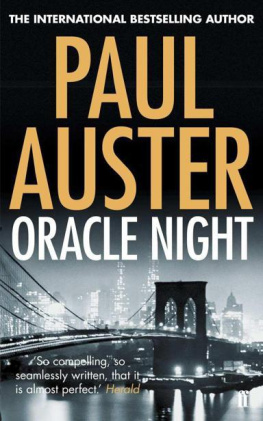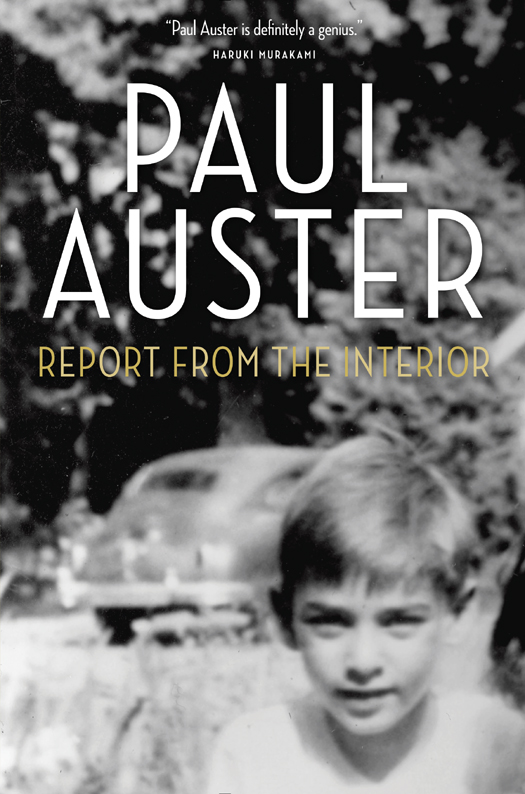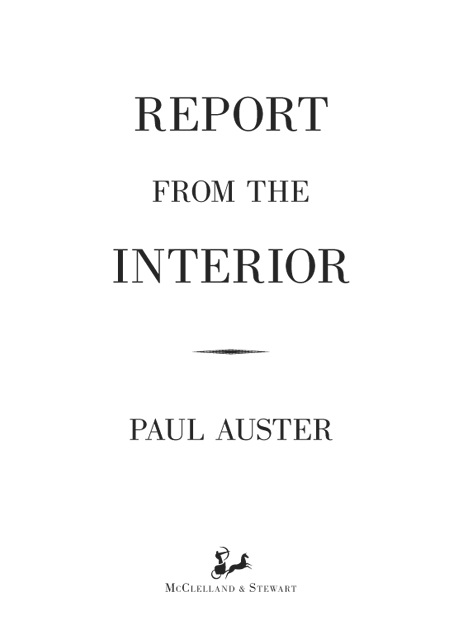A LSO BY P AUL A USTER
NOVELS
The New York Trilogy
(City of Glass, Ghosts, The Locked Room)
In the Country of Last Things
Moon Palace
The Music of Chance
Leviathan
Mr. Vertigo
Timbuktu
The Book of Illusions
Oracle Night
The Brooklyn Follies
Travels in the Scriptorium
Man in the Dark
Invisible
Sunset Park
NONFICTION
The Invention of Solitude
The Art of Hunger
Why Write?
Hand to Mouth
The Red Notebook
Collected Prose
Winter Journal
Here and Now
(with J. M. Coetzee)
SCREENPLAYS
Three Films:
Smoke, Blue in the Face,
Lulu on the Bridge
The Inner Life of Martin Frost
POETRY
Collected Poems
ILLUSTRATED BOOKS
The Story of My Typewriter
(with Sam Messer)
Auggie Wrens Christmas Story
(with Isol)
City of Glass
(adapted by Paul Karasik and David Mazzucchelli)
EDITOR
The Random House Book of Twentieth-Century French Poetry
I Thought My Father Was God and Other True Tales
from NPRs National Story Project
Samuel Beckett:
The Grove Centenary Edition
Copyright 2013 by Paul Auster
All rights reserved. The use of any part of this publication reproduced, transmitted in any form or by any means, electronic, mechanical, photocopying, recording, or otherwise, or stored in a retrieval system, without the prior written consent of the publisher or, in case of photocopying or other reprographic copying, a licence from the Canadian Copyright Licensing Agency is an infringement of the copyright law.
LIBRARY AND ARCHIVES CANADA CATALOGUING IN PUBLICATION
Auster, Paul, 1947-, author
Report from the interior / Paul Auster.
ISBN 978-0-7710-0907-5 (bound).ISBN 978-0-7710-0908-2 (html)
1. Auster, Paul, 1947-. 2. Authors, American20th centuryBiography. I. Title.
PS3551.U75Z46 2013b 818.5403 C2013-902200-7
C2013-902201-5
eBook ISBN: 978-0-7710-0908-2
Jacket design by Terri Nimmo
McClelland & Stewart,
a division of Random House of Canada Limited
One Toronto Street
Suite 300
Toronto, Ontario
M5C 2V6
www.randomhouse.ca
v3.1
CONTENTS
REPORT FROM THE INTERIOR
In the beginning, everything was alive. The smallest objects were endowed with beating hearts, and even the clouds had names. Scissors could walk, telephones and teapots were first cousins, eyes and eyeglasses were brothers. The face of the clock was a human face, each pea in your bowl had a different personality, and the grille on the front of your parents car was a grinning mouth with many teeth. Pens were airships. Coins were flying saucers. The branches of trees were arms. Stones could think, and God was everywhere.
There was no problem in believing that the man in the moon was an actual man. You could see his face looking down at you from the night sky, and without question it was the face of a man. Little matter that this man had no bodyhe was still a man as far as you were concerned, and the possibility that there might be a contradiction in all this never once entered your thoughts. At the same time, it seemed perfectly credible that a cow could jump over the moon. And that a dish could run away with a spoon.
Your earliest thoughts, remnants of how you lived inside yourself as a small boy. You can remember only some of it, isolated bits and pieces, brief flashes of recognition that surge up in you unexpectedly at random momentsbrought on by the smell of something, or the touch of something, or the way the light falls on something in the here and now of adulthood. At least you think you can remember, you believe you remember, but perhaps you are not remembering at all, or remembering only a later remembrance of what you think you thought in that distant time which is all but lost to you now.
January 3, 2012, exactly one year to the day after you started composing your last book, your now-finished winter journal. It was one thing to write about your body, to catalogue the manifold knocks and pleasures experienced by your physical self, but exploring your mind as you remember it from childhood will no doubt be a more difficult taskperhaps an impossible one. Still, you feel compelled to give it a try. Not because you find yourself a rare or exceptional object of study, but precisely because you dont, because you think of yourself as anyone, as everyone.
The only proof you have that your memories are not entirely deceptive is the fact that you still occasionally fall into the old ways of thinking. Vestiges have lingered well into your sixties, the animism of early childhood has not been fully purged from your mind, and each summer, as you lie on your back in the grass, you look up at the drifting clouds and watch them turn into faces, into birds and animals, into states and countries and imaginary kingdoms. The grilles of cars still make you think of teeth, and the corkscrew is still a dancing ballerina. In spite of the outward evidence, you are still who you were, even if you are no longer the same person.
In thinking about where you want to go with this, you have decided not to cross the boundary of twelve, for after the age of twelve you were no longer a child, adolescence was looming, glimmers of adulthood had already begun to flicker in your brain, and you were transformed into a different kind of being from the small person whose life was a constant plunge into the new, who every day did something for the first time, even several things, or many things, and it is this slow progress from ignorance toward something less than ignorance that concerns you now. Who were you, little man? How did you become a person who could think, and if you could think, where did your thoughts take you? Dig up the old stories, scratch around for whatever you can find, then hold up the shards to the light and have a look at them. Do that. Try to do that.
The world was of course flat. When someone tried to explain to you that the earth was a sphere, a planet orbiting the sun with eight other planets in something called a solar system, you couldnt grasp what the older boy was saying. If the earth was round, then everyone below the equator would fall off, since it was inconceivable that a person could live his life upside down. The older boy tried to explain the concept of gravity to you, but that was beyond your grasp as well. You imagined millions of people plunging headlong through the darkness of an infinite, all-devouring night. If the earth was indeed round, you said to yourself, then the only safe place to be was the North Pole.
No doubt influenced by the cartoons you loved to watch, you thought there was a pole jutting out from the North Pole. Similar to one of those striped, revolving columns that stood in front of barbershops.
Stars, on the other hand, were inexplicable. Not holes in the sky, not candles, not electric lights, not anything that resembled what you knew. The immensity of the black air overhead, the vastness of the space that stood between you and those small luminosities, was something that resisted all understanding. Benign and beautiful presences hovering in the night, there because they were there and for no other reason. The work of Gods hand, yes, but what in the world had he been thinking?


